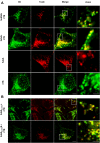The enzyme subunit SubA of Shiga toxin-producing E. coli strains demonstrates comparable intracellular transport and cytotoxic activity as the holotoxin SubAB in HeLa and HCT116 cells in vitro
- PMID: 33483759
- PMCID: PMC7904543
- DOI: 10.1007/s00204-020-02965-2
The enzyme subunit SubA of Shiga toxin-producing E. coli strains demonstrates comparable intracellular transport and cytotoxic activity as the holotoxin SubAB in HeLa and HCT116 cells in vitro
Abstract
The subtilase cytotoxin (SubAB) is secreted by certain Shiga toxin-producing Escherichia coli (STEC) strains and is composed of the enzymatically active subunit SubA and the pentameric binding/transport subunit SubB. We previously demonstrated that SubA (10 µg/ml), in the absence of SubB, binds and intoxicates the human cervix cancer-derived epithelial cell line HeLa. However, the cellular and molecular mechanisms underlying the cytotoxic activity of SubA in the absence of SubB remained unclear. In the present study, the cytotoxic effects mediated by SubA alone were investigated in more detail in HeLa cells and the human colon cancer cell line HCT116. We found that in the absence of SubB, SubA (10 µg/ml) is internalized into the endoplasmic reticulum (ER), where it cleaves the chaperone GRP78, an already known substrate for SubA after its canonical uptake into cells via SubB. The autonomous cellular uptake of SubA and subsequent cleavage of GRP78 in cells is prevented by treatment of cells with 10 µM brefeldin A, which inhibits the transport of protein toxins into the ER. In addition, by analyzing the SubA mutant SubAΔC344, we identified the C-terminal SEEL motif as an ER-targeting signal. Conclusively, our results strongly suggest that SubA alone shares the same intracellular transport route and cytotoxic activity as the SubAB holotoxin.
Keywords: Cellular uptake; GRP78; Intracellular transport; Shiga toxin-producing Escherichia coli (STEC); Subtilase cytotoxin.
Conflict of interest statement
The authors declare no conflict of interest.
Figures




Similar articles
-
Novel Aspects of the SubA Subunit of the Subtilase Cytotoxin.Toxins (Basel). 2022 Feb 21;14(2):156. doi: 10.3390/toxins14020156. Toxins (Basel). 2022. PMID: 35202183 Free PMC article. Review.
-
Host response to the subtilase cytotoxin produced by locus of enterocyte effacement-negative Shiga-toxigenic Escherichia coli.Microbiol Immunol. 2020 Oct;64(10):657-665. doi: 10.1111/1348-0421.12841. Epub 2020 Sep 29. Microbiol Immunol. 2020. PMID: 32902863 Review.
-
Uptake of Shiga-toxigenic Escherichia coli SubAB by HeLa cells requires an actin- and lipid raft-dependent pathway.Cell Microbiol. 2014 Oct;16(10):1582-601. doi: 10.1111/cmi.12315. Epub 2014 Jun 17. Cell Microbiol. 2014. PMID: 24844382 Free PMC article.
-
Subtilase cytotoxin produced by locus of enterocyte effacement-negative Shiga-toxigenic Escherichia coli induces stress granule formation.Cell Microbiol. 2016 Jul;18(7):1024-40. doi: 10.1111/cmi.12565. Epub 2016 Feb 21. Cell Microbiol. 2016. PMID: 26749168 Free PMC article.
-
Incorporation of a non-human glycan mediates human susceptibility to a bacterial toxin.Nature. 2008 Dec 4;456(7222):648-52. doi: 10.1038/nature07428. Epub 2008 Oct 29. Nature. 2008. PMID: 18971931 Free PMC article.
Cited by
-
Novel Aspects of the SubA Subunit of the Subtilase Cytotoxin.Toxins (Basel). 2022 Feb 21;14(2):156. doi: 10.3390/toxins14020156. Toxins (Basel). 2022. PMID: 35202183 Free PMC article. Review.
-
Excess A-subunits of Shiga toxin 2a are produced in enterohemorrhagic Escherichia coli.Sci Rep. 2025 May 14;15(1):16712. doi: 10.1038/s41598-025-01342-2. Sci Rep. 2025. PMID: 40368985 Free PMC article.
-
Enterohemorrhagic Escherichia coli and a Fresh View on Shiga Toxin-Binding Glycosphingolipids of Primary Human Kidney and Colon Epithelial Cells and Their Toxin Susceptibility.Int J Mol Sci. 2022 Jun 21;23(13):6884. doi: 10.3390/ijms23136884. Int J Mol Sci. 2022. PMID: 35805890 Free PMC article. Review.
-
Cytotoxic Effects of Recombinant StxA2-His in the Absence of Its Corresponding B-Subunit.Toxins (Basel). 2021 Apr 26;13(5):307. doi: 10.3390/toxins13050307. Toxins (Basel). 2021. PMID: 33925951 Free PMC article.
References
-
- de Castro E, Sigrist CJA, Gattiker A, Bulliard V, Langendijk-Genevaux PS, Gasteiger E, et al. ScanProsite: detection of PROSITE signature matches and ProRule-associated functional and structural residues in proteins. Nucleic Acids Res. 2006;34(Web server issue):W362–W365. doi: 10.1093/nar/gkl124. - DOI - PMC - PubMed
Publication types
MeSH terms
Substances
LinkOut - more resources
Full Text Sources
Other Literature Sources
Miscellaneous

